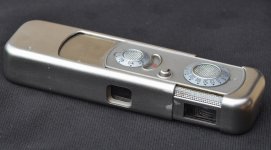I would like to hear some ideas on how to machine the knurling like surfaces on the buttons of the camera below. I image machining a planar version of this pattern would be no major problem with a D bit engraver, but the concave curvature of the surface seems to be tricky to machine. 
I expect many ideas on how you would tackle such a quite difficult task.


I expect many ideas on how you would tackle such a quite difficult task.



